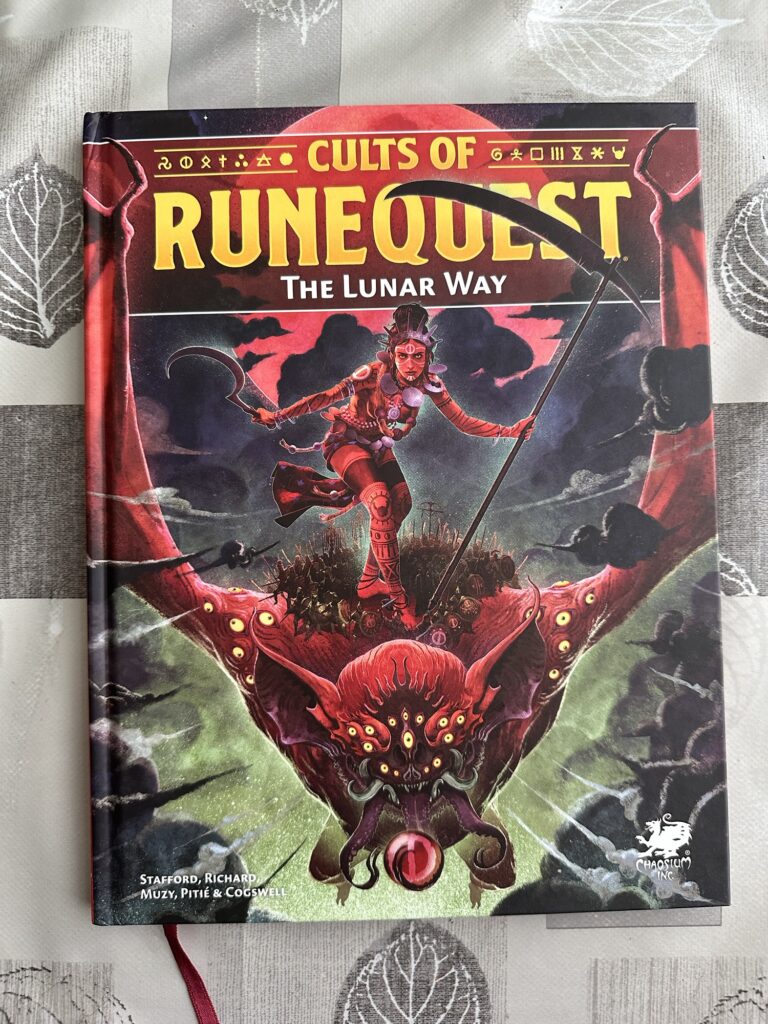
With the release of The Lunar Way comes the time for yet another Cults of RuneQuest book review! Time is a cyclical thing, as the Red Goddess teaches us… You can read the other reviews here.
I got my copy of The Lunar Way at ChaosiumCon 2024, so unlike the previous reviews, this one wasn’t written based on a review copy sent by Chaosium. I lined up for it like everybody else!
Behold the Mistress of Life and Death
The general appearance of Cults of RuneQuest: The Lunar Way is consistent with the other books in the series: beautiful, evocative, and functional.
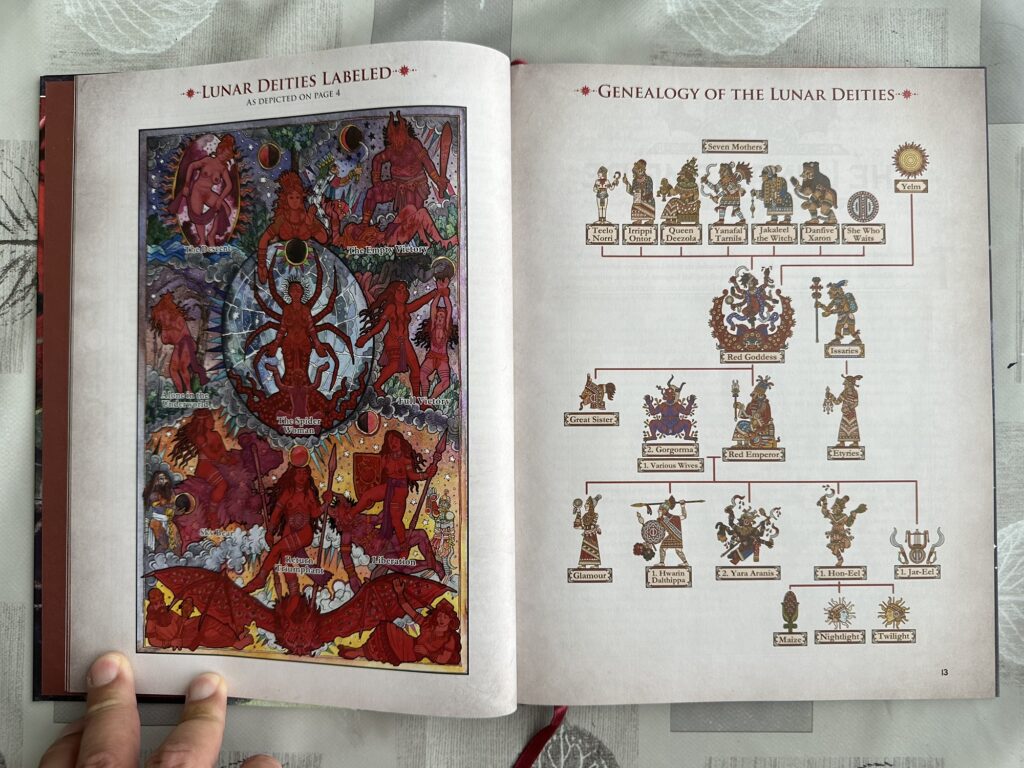
From the bombastic cover by Loic Muzy, featuring the Red Goddess ready to kick some ass atop the Crimson Bat, to Katrin Dirim’s many illuminated illuminations, featuring the usual mix of real-world inspirations, the book is gorgeous in a way that is easy to be jaded about after its predecessors. The other usual art suspects are of course present, such as Agathe Pitie’s epic monomyth pieces or Ossi Hiekkala’s slice-of-life scenes. One interesting guest artist is Eric Vanel, known around our Gloranthan circles as the sculptor of an amazing Jar-eel statue… nice to see him here!
Simeon Cogswell’s layout follows the standard they established from the beginning of the series, but of course this time with an overall “red moon” theme to all design elements. This resulted in a small gripe for me: the lower-left page “coloured splash” background element seems a bit too dark to me and made some bits of text uncomfortable to read. Nothing is outright unreadable, so it’s OK, I guess, but I’m sure I won’t be the only one thinking this.
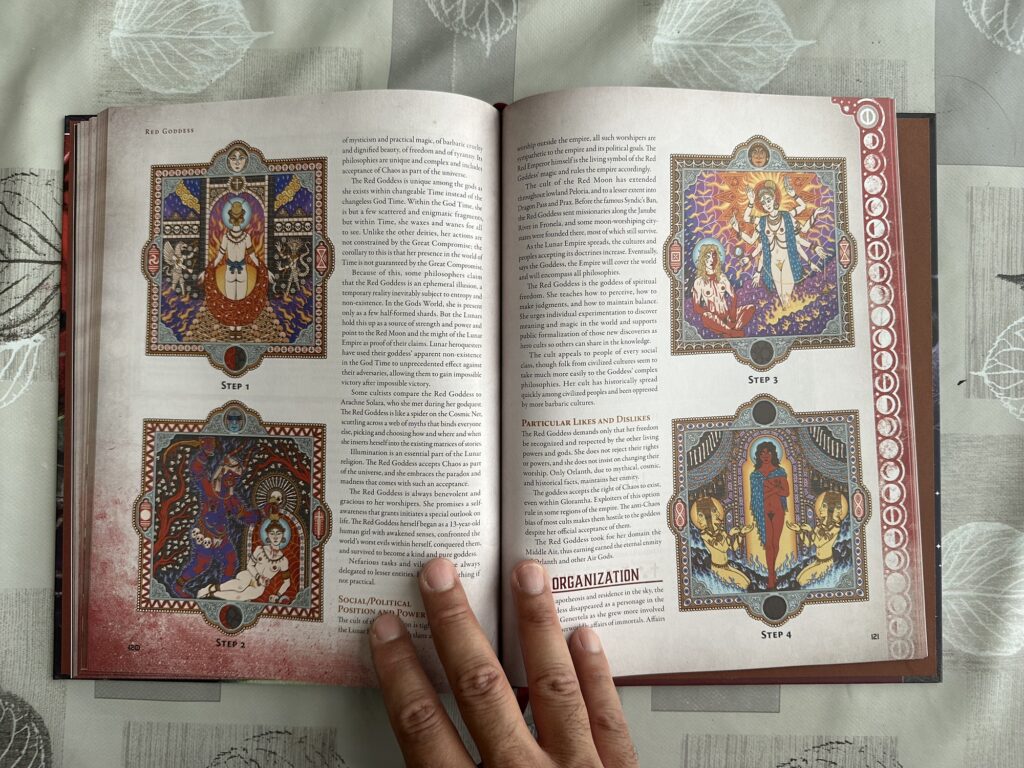
This being a RuneQuest Glorantha book, you’ll of course find nudity, especially female nudity since a lot of it revolves around the Red Goddess and her priestesses (I’m expecting male nudity with the upcoming Solar pantheon book… I’m looking at you and your handsome butt, Lodril!)
As usual, the nudity is far from your usual sexualized fantasy tropes: it’s more about channelling the aesthetic of the ancient world, and embracing the feminine side of mythology. However, I feel like I have to mention it in case you have one of those easily offended people at your table, especially because this book arguably includes under-age nudity with Teelo Norri and (depending on your reading of those events) the Seven Steps of the Red Goddess’ Rebirth.
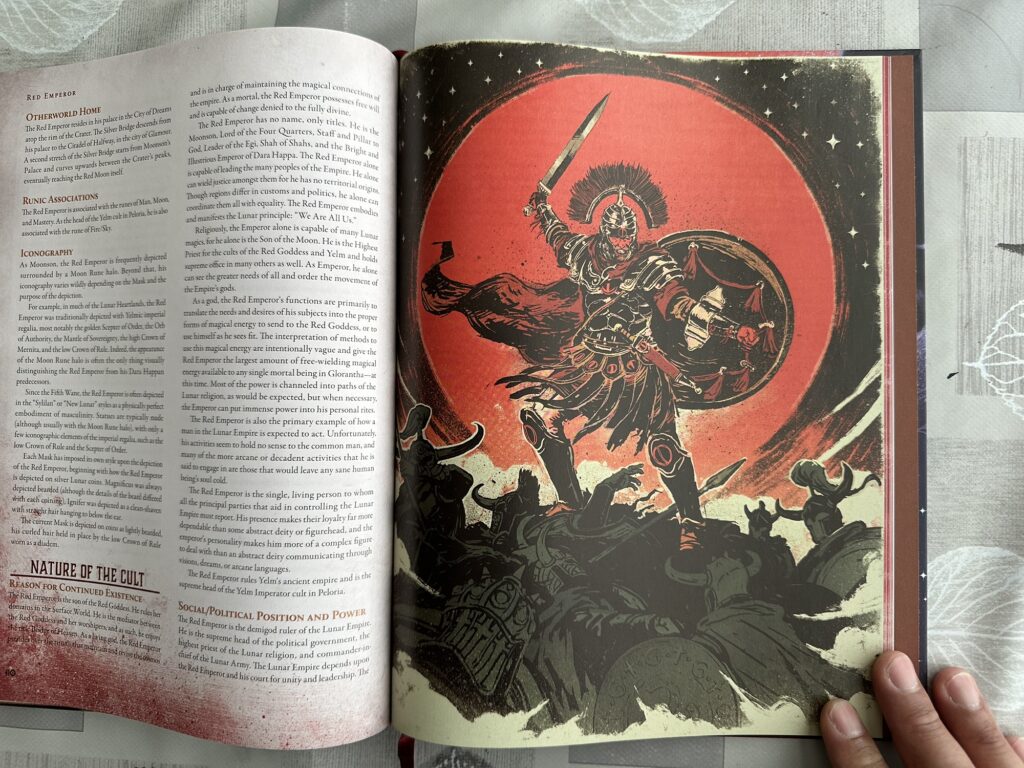
There are several illustrations I really like in this book, such as the Crimson Bat (both the main chapter piece and the one where it devours a whole army), or Danfive Xaron’s cool look. But if I had to pick, I’d say my personal favourites in this book are the mighty-looking Hwarin Dalthippa on page 70 (doing her best impersonation of Athena), and the Red Emperor kicking ass on page 111 (totally not looking like a Roman, oh no sir, Lunars aren’t analogs for the Romans, right?)
Chaos, Chaos Everywhere
The Lunar Way follows the familiar structure of the Cults of RuneQuest series: an introduction, some short prayer for mood, the Lunars’ views on the world, other gods, and other cultures, a mini-Prosopaedia, and the list of cults write-ups proper. But just as the Red Goddess mixes things up with Chaos to defy the expected order of the cosmos, this book does too!
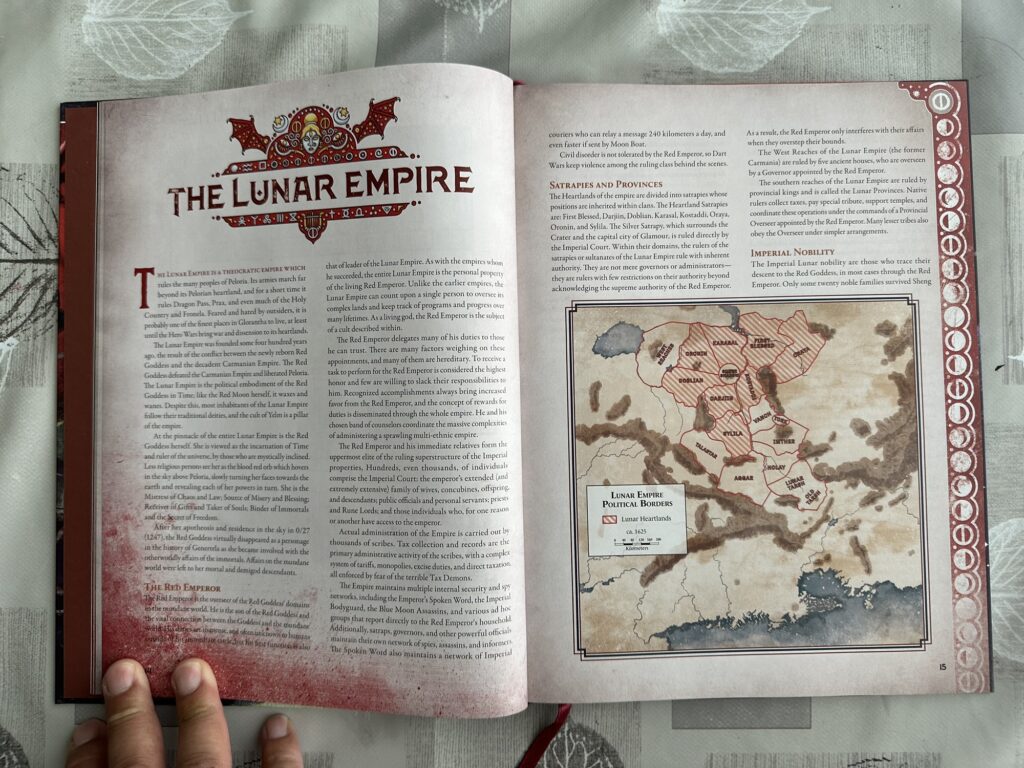
First, the introduction includes a section describing the mess of Glorantha’s many ancient moon goddesses. Between that section and the following chapters, the authors make it clear that the Red Goddess is some sort of Frankenstein-deity assembled from dead moon goddesses by a bunch of crazy wizards who used Chaos as Elmer’s glue. Fun, isn’t it?
Second, there’s a 12 pages-long chapter on the Lunar Empire that explains what it is and how it works, from the Emperor to its armies, its provinces and satrapies, its noble families and history. It starts very well but, in my opinion, takes a wrong turn by allocating 7 pages to the geography of the Red Moon itself.
While I’m all for crazy RuneQuest campaigns involving trips to the Sky World or the God Time, this isn’t the sort of game Chaosium has published so far in this product line, so why is this section here? I would have vastly preferred these 7 pages spent on the terrestrial Lunar Empire, especially since the rest of the book keeps referring to many places that people wouldn’t know about without access to the Glorantha Sourcebook or the Guide to Glorantha. I had already raised this concern in the previous two pantheon books, but it was a minor problem then, as those books sent you outside of Dragon Pass or Prax only on occasion. Here, however, the whole Pelorian bowl is at the centre of the Lunar geography, history, and culture… and none of it has been presented or mapped out for the newcomers except for Tarsh in the rulebook.
I guess you can use the Argan Argar Atlas, free in PDF, to try and make a bit more sense out of it.
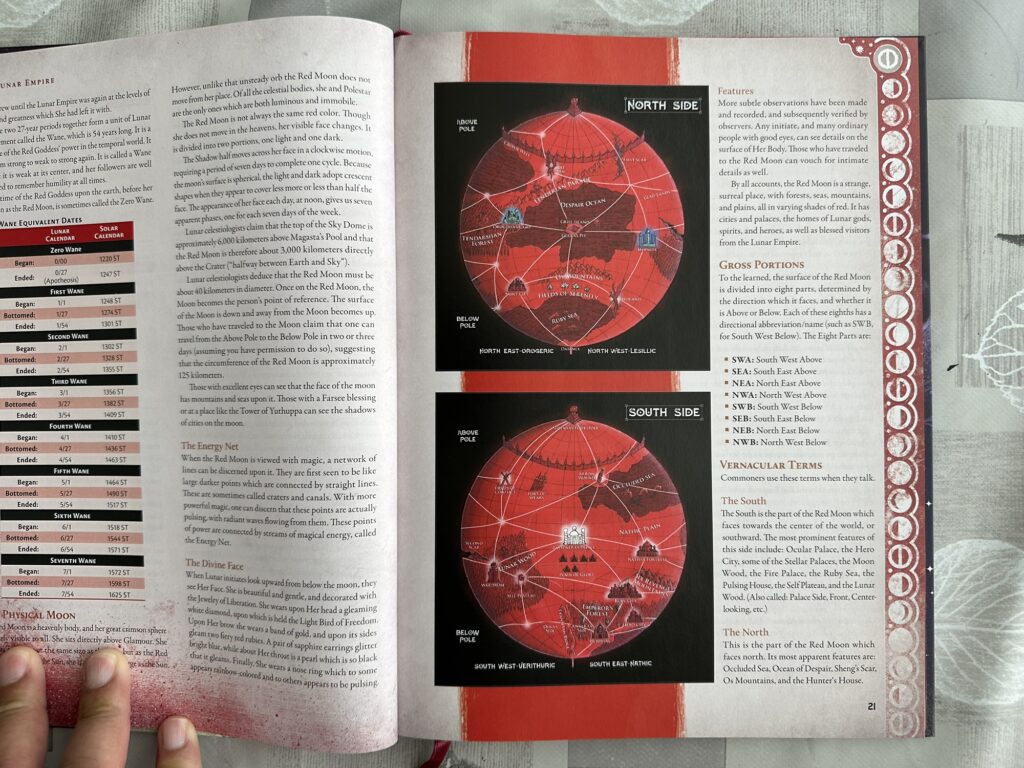
Going back to the various ways this book mixes up the formula bit, we’ve got (as number three if you kept count) the fact that almost none of the Lunar cults have anything in the “Before Time” section of the standard cult write-up defined in the Mythology book. That’s of course because almost all Lunar cults are, again, a bunch of bullshit made up by crazy Pelorian wizards. And yes, yes, it’s not so much “made-up bullshit” as it is, err, “discovered by dangerous experimental heroquesting” or whatever. But we all know how heroquesting works, right? Everything is made-up bullshit! Including the rules! Because they still don’t exist!
And yes, this is your obligatory dig at Chaosium for still not having released the heroquesting rules, even though this Lunar Way book is all about how heroquesters can do super awesome stuff like make up new gods and become gods themselves... oh, the infamy!
Okay, back on track. Fourth, we have a blurring of the line between the concept of a deity and a hero. Like I just said, most of the Lunar gods were mortals who ascended to godhood, some of whom did that pretty recently: less than 150 years before the “present time”. That’s very cool, although mechanically speaking it “just” boils down to a cult with less cultural and political footprint, and fewer, more targeted spells (and sometimes not even any spell, such as with the Red Emperor, weirdly enough) Not that I’m complaining: this is a good place where re-using the same structure and mechanics as elsewhere is a good idea.
Fifth, and last, the entry on Nysalor/Gbaji includes a whole treatise on the nature of Chaos and Illumination, its role and significance in Glorantha, and it almost breaks the fourth wall while doing it. That chapter was a really fun and fascinating read.
Repetition is a Form of Cyclicity
Since I mentioned the editing and the other big books of Gloranthan lore, it’s time for our usual check-up on how what sort of actual material we get in this Lunar Way book.
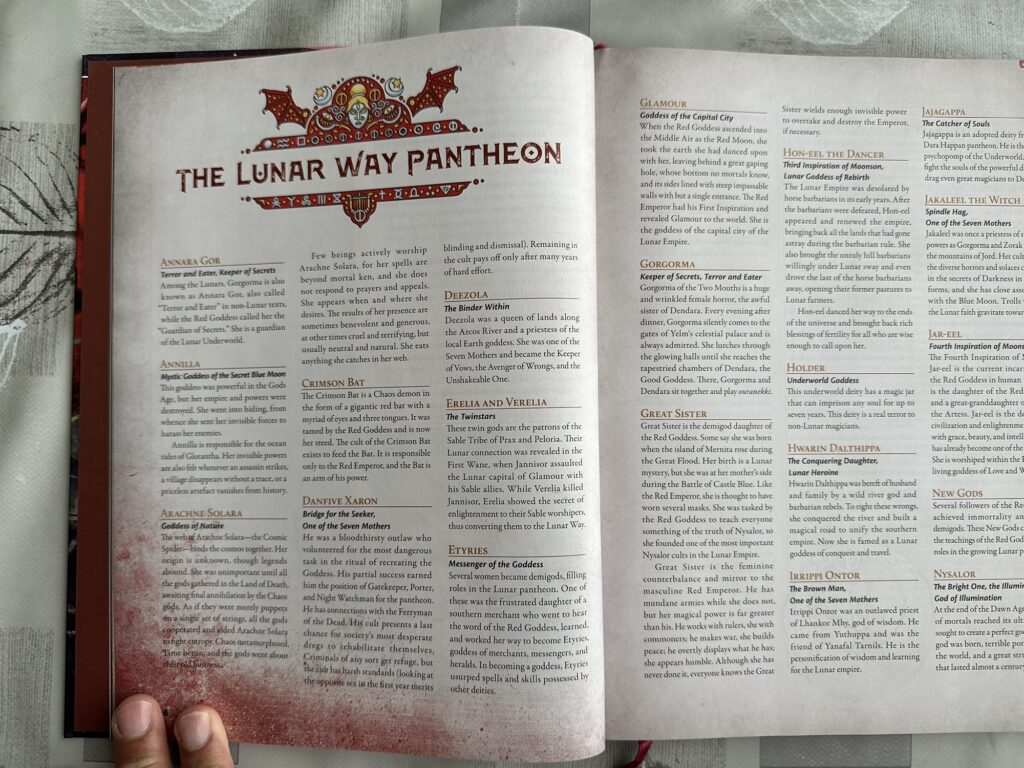
We still have strange repetitions of text in the book. This repetition of a sentence here or short paragraph there is starting to look consistent with the previous two pantheon books so I’m starting to think it’s by choice, which is even more puzzling to me than if it was by mistake.
Some other bits of text, like the sidebar on the Lunar New Year Ceremony, are repeated from other books in the series. Several chunks of text, like the gazetteer of the Red Moon, the list of noble Lunar families, and of course the history of the empire across the Wanes, are taken and edited from the Guide to Glorantha and the Glorantha Sourcebook. In some cases, they are heavily edited, rewritten, summarized, and scattered around.
One particular repetition is the explanation of Cyclic Rune Magic, which affects all Lunar magic: it is repeated in each write-up! Wait, no, it’s not. The Crimson Bat doesn’t have it, which makes sense because it’s got its own Glowspot. But Etyries, Hon-eel, Irripi Ontor, and Yara Aranis don’t have it, even though as far as I can tell their Rune magic should be subject to the moon’s phases, no? Or did I miss something? Anyway, if you’re an editor, you might also “enjoy” the fact that this repeated section is sometimes titled “Lunar Cyclical Magic”, and sometimes “Cyclic Rune Magic”… oh well.
Most cults also have an entry for the Glowline, but that entry varies a lot from one version to the other. This time, Etyries, Hon-eel, and Irripi Ontor also don’t have that entry, but of course Yara Aranis does have it, given that she sort of created it. Even more so than for the cyclic Lunar Rune magic, I’m confused as to why the editors didn’t choose to consolidate some of that stuff in the preamble chapters. I can understand that they maybe wanted each cult to be “self-contained”, but I personally think it ends up being confusing, and a waste of space.
A Better Sim-Glorantha
As with the previous Cults of RuneQuest pantheon books, The Lunar Way continues to follow the game-design philosophy of “sim-Glorantha”. By that, I mean that the cults presented here are first meant to model what the cults are in the fiction of setting, rather than first meant to address specific desired gameplay experiences which is, for instance, 13th Age Glorantha’s approach.

For example, Danfive Xaron, Teelo Norri, or Yara Aranis are presented “as is”, so to speak, and each player will have to figure out what they want to do with those cults. You have to find your own fun, basically. Teelo Norri is even called out in the introduction as an example of a cult that is “of little use for adventurers but are included because they are important to understanding the Lunar Way.” Of course, this isn’t new: RuneQuest in general, and RuneQuest Glorantha more than the previous editions, have always been a “find your own fun” sort of game.
For many Glorantha fans, I suspect that this is actually part of the appeal: you learn about a cult, it gives you an idea for a cool character concept, and you get to play it! For newcomers, however, it may not be so nice to give them 200+ pages of lore and say “here, find what sounds cool to you, and figure out a character!” Just as with any of the other RuneQuest books, gamemasters might want to familiarize themselves with the cults and make a mental correspondence table with typical gameplay roles (negotiator, fighter, hedge witch, politician, etc.) in order to advise new players.

Now, the sim-Glorantha approach didn’t always work well for me in the past. For instance, I often complain that the RuneQuest rulebook has no less than 3 hunting cults with no clear distinction between them. Sometimes, the sim-Glorantha approach gets further bogged down by the simulationist aspects of the RuneQuest rules: in the Lightbringers pantheon review, I complained that Valind was given super lame magic that decreases the temperature by a number of degrees proportional to your magic point spend. This frankly still makes me tired just thinking about it.
I’m happy to say that the Lunar Way feels better designed on that front. The magical abilities of the different cults are still firmly anchored in the setting’s lore, which is what we like about Glorantha, but it’s also… well, not so lame. For instance, Hwarin Dalthippa became a heroine of the Lunar Empire after building roads, bridges, and towns that facilitated the imperial conquests of her father. Her main magic spells, Create Bridge and Daughter’s Road, are both intimately tied to her history, and allow for creative thinking on the part of the player to use in play. I may not like some details of those spells’ mechanics, but they showcase a good marriage between setting lore and game mechanics.
PCs vs NPCs
While reading The Lunar Way, it occurred to me that a lot of the stuff I enjoyed from the book was done with my “gamemaster’s hat” firmly on. It’s a great sourcebook, but I think the other pantheon books are better player facing splatbooks.

This may change over the next few years, but right now I doubt many gaming groups recently arrived to Glorantha with the new RuneQuest edition would be playing a campaign set in the Lunar Empire. As a result, many cults of the Lunar Way are in my opinion reserved for the gamemaster’s NPCs: the Crimson Bat, Nysalor, the Red Emperor, the Red Goddess, Teelo Norri, and Yara Aranis are rather hard to justify for PCs in a Sartarite or Praxian campaign in my opinion.
On the other hand, the other cults can add absolutely wonderful dynamics to your group. A Danfive Xaron penitent can bring great roleplaying opportunities of Lunar proselytizing. A Hwarin Dalthippa or Yanafal Tarnils cultist can bring a bit of variety to a group of mercenaries. In fact, some of the Lunar cults, like Etyries or Irrippi Ontor, are only interesting to me as counterparts to their Lightbringers’ inspiration. I don’t find these two Lunar cults compelling by themselves, but playing their biases and Imperial agendas against an Issaries or Lhankor Mhy character should be quite fun!
The only Lunar cult I’m pretty indifferent to is probably Deezola, whose role seems quite weakly defined. I can’t really tell you what she’s about, and why you should use her for your PC or NPC, except if what you’re looking for is “discount Ernalda”. Given how short Deezola’s cult write-up is, it seems the authors don’t quite know what to do with her either.
Illumination and Lunar Magic
The Lunar Way introduces two big new mechanics: Illumination, and Lunar Magic.
Let’s quickly go over Lunar Magic, which you probably won’t use much except for some big villain NPC. This is because using Lunar Magic requires to be specifically a Red Goddess initiate, which in turn requires to be Illuminated.
What you get is more or less the ability to manipulate Spirit Magic in the same way as Sorcery spells: you can amplify, combine, and extend in space and time any other Spirit Magic spell… although that requires casting the corresponding Amplify, Combine, Distance, and Prolong modifier spells. If you thought you were already rolling dice a lot in RuneQuest, wait until your Lunar Magician starts doing augments before casting combined manipulated spells!
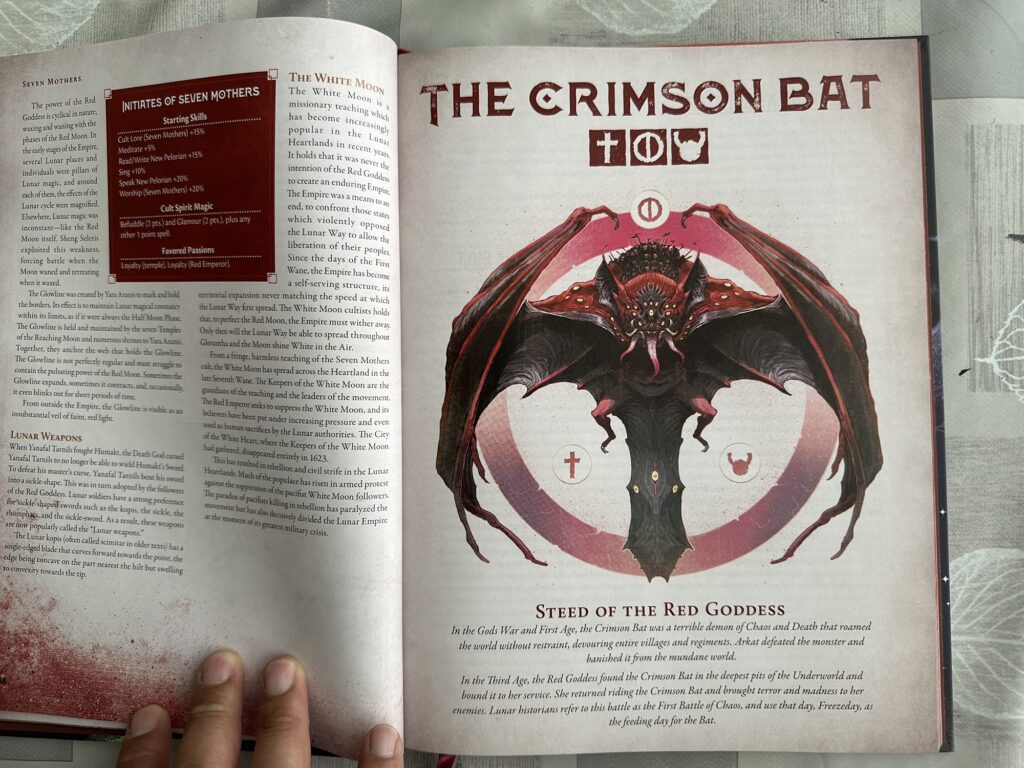
Illumination is of course presented from the perspective of the Lunar Way. This means that the path to become Illuminated goes through Nysalorean Riddles, which means Illumination is described in the Nysalor/Gbaji write-up.
The mechanics of Illumination and Nysalorean Riddles are pretty straightforward.
Each Riddle is a semi-obscure question, the answer to which can be found by succeeding a specific skill roll. So there’s a “Climbing Riddle”, a “Move Quietly Riddle”, an “Insight Riddle”, and so on. There is no canonical list of Riddles, you just make them up as needed, but there are a couple of examples. While other parts of the Lunar Way book managed to be quite deep and philosophical at times, I found that the example Riddles, which are also meant to be “revelatory” in some way, fell rather flat.
Successfully answering a Riddle gives +1% to your Illumination skill. Other experiences can provide bonuses, at the gamemaster’s discretion, such as special Lunar rites or heroquesting (how do we do that again?) Each year, during Sacred Time, you roll the Illumination skill. On a success, you achieve Illumination. A bit anti-climactic, I know, but not as much as the next bit: upon reaching Illumination, you get a certain number of Illumination Powers, which are a bit like the Shamanic Abilities. How many do you get? Well, your gamemaster decides! How effective and reliable are they? Your gamemaster also decides!
I would have vastly preferred it if attaining Illumination was a “push your luck” affair, like Shamanic Initiation. How well you do navigating the intellectual and moral maze that leads to Illumination would define how many powers you get, but pushing your luck too far could shatter your mind. That would have been cool, I think!
Listen, I’m Not Crazy
Before we finish, I have to share my Lunar conspiracy theory, that I’ll prove to you with the editorial choices of The Lunar Way.
If we look at the first two pantheon books, The Lightbringers and The Earth Goddesses, we see that the cult write-ups are organized as follows: first, the head deity, and most popular deity of the pantheon, is presented, and then the rest of the pantheon is listed in alphabetical order. Orlanth and Ernalda are featured first in their respective books.

The Lunar Way however starts with the Seven Mothers. The Red Goddess is buried in the alphabetical listing of the other deities… does this mean the Seven Mothers are first just because they are the most popular of the Lunar cults? Fuck no! That’s what they want you to think!
No no no, the Seven Mothers are the heads of the pantheon. The Red Goddess is, at best, a servant deity used by the Seven Mothers to focus people’s worship into something that looks like a “higher being”. She’s basically a God Time actress hired and controlled by a cabal of crazy heroquesters. At worse, the Red Goddess isn’t even real! She didn’t come back from Hell riding the Crimson Bat… the Crimson Bat came back from Hell with her corpse on its back. It animates her like a sock puppet to make people believe that someone’s got it “under control”, but really the Crimson Bat forced its way into the Seven Mothers’ scam and now they have to feed it.
And yes, I got all this just from the editorial ordering of chapters in the book. I’m not crazy, I swear!

Last Words
So that’s Cults of RuneQuest: The Lunar Way. It provides a deep look at the Lunar Empire which I think complements that of the Glorantha Sourcebook. I actually highly recommend getting the Glorantha Sourcebook for two reasons: it gives you maps that help place the various geographical references you’ll encounter, and while The Lunar Way scatters some of the empire’s history across different cults, the Sourcebook gives you one single chronological history that may be easier to follow.
The Lunar Way may be useful to some players, but I think it is currently more broadly useful to gamemasters. Players may only see a cruel tease that heroquesters can do really cool stuff, while still waiting for Chaosium to release the heroquesting rules that would let them to do the same.
In some places, The Lunar Way achieves great heights of writing for a roleplaying supplement: some of the philosophical concepts and mythological elements included therein can resonate with the reader in a deep way not often seen in gaming material. The fact that these concepts and elements are lifted from real-world philosophies and myths doesn’t take anything away from this book: instead, I tip my hat to the writers who had the audacity and talent to incorporate such topics into a roleplaying book.
The Lunar Way has the Chaotic Feature of oozing great mythology and memorable characters, and as such I find it the best of the Cults of RuneQuest pantheon books so far. You can get the book in hardcover and/or PDF from Chaosium. You can also get the PDF from DriveThruRPG. The Glorantha Sourcebook is of course also available in hardcover and/or PDF from Chaosium, and in PDF from DriveThruRPG.


